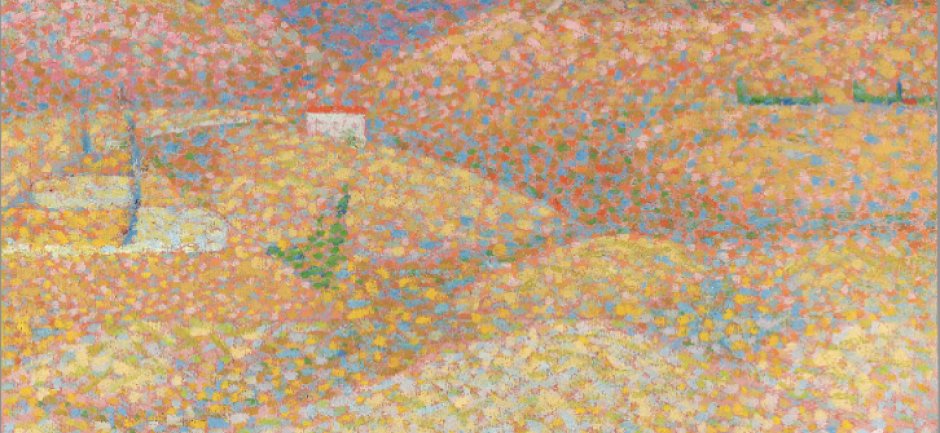Bridget Riley: Learning from Seurat
- The Courtauld Gallery presents Bridget Riley: Learning from Seurat, an exploration of Bridget Riley’s early breakthrough encounter with Georges Seurat’s Bridge at Courbevoie, a highlight of The Courtauld’s collection
- For the first time, it brings together the copy that Riley made of Bridge at Courbevoie in 1959 with Seurat’s original painting to consider this remarkable moment of artistic connection and inspiration
- The focused display presents a small group of Riley’s seminal paintings to chart how her understanding of Seurat’s art has led her to create some of the most radical and original abstract works of the past five decades
- It is part of The Courtauld Gallery’s ongoing series of special displays of works by major contemporary artists
- The display will run from 17 September 2015 to 17 January 2016
- For further images and information, please email courtauld@kallaway.com
Bridget Riley (born 1931) is one of the leading artists of her generation. She rose to prominence in London in the 1960s with her bold vision for a new language of painting based upon repeated geometric forms. Although Riley’s work is often thought to epitomise a new spirit in painting, which was born of the liberating years of the 1960s, her practice is deeply rooted in the art of the past. One of the most abiding and important influences upon Riley’s art is the work of the French Post-Impressionist Georges Seurat (1859-91). This special display explores Riley’s early seminal encounter with a single painting by Seurat that has profoundly shaped her artistic development.
In 1959 Riley painted a copy of Seurat’s Bridge at Courbevoie (1887), one of the highlights of The Courtauld Gallery’s collection. It proved to be a breakthrough moment for the artist by offering her a new understanding of colour and perception. The lessons that Riley learned from Seurat emboldened her to strike out into the realm of pure abstraction. Over the following few years she produced the first major abstract paintings which brought the artist to great international renown.
This focused exhibition curated by Dr. Barnaby Wright, Daniel Katz Curator of 20th Century Art, explores this breakthrough period by bringing Riley’s version of Bridge at Courbevoie together with the original for the first time. It will chart how, in the early 1960s, she moved on to produce her own pointillist paintings, such as Pink Landscape (1960), before making the extraordinary leap into pure abstraction with black and white canvases, such as Tremor (1962). This artistic exploration culminated with the creation of Riley’s now famous stripe paintings, including Late Morning 1 (1967)that powerfully demonstrates how she extended and transformed Seurat’s example into her own artistic language. Just as Seurat’s dots of pure colour were a radical intervention within the art world of the 1880s, so Riley’s coloured stripes have redefined abstract art since the 1960s.
The display will also include examples of the artist’s recent paintings that continue her exploration of colour and perception that began with Bridge at Courbevoie. Riley has returned to Seurat’s example throughout her career, especially inthe way that he creates light in his canvases. These paintings, such as Ecclesia (1985), remind us that looking at Seurat continued to offer Riley fresh creative perspectives at pivotal points throughout her artistic development.
Bridget Riley: Learning from Seurat will be an opportunity to follow the early artistic journey of one this country’s greatest living artists. It will also allow us to look at Seurat afresh, through Riley’s eyes. The exhibition will be accompanied by a fully illustrated publication incorporating writings by Riley herself, published by The Courtauld Gallery and Ridinghouse in September 2015.
Ernst Vegelin, Head of The Courtauld Gallery, says: “It is a privilege to present this illuminating focused exhibition of works by Bridget Riley, one of our most important living artists. It is thrilling to be able to celebrate her profound connection to Seurat’s Bridge at Courbevoie, one of the highlights of The Courtauld Gallery’s collection.”
The exhibition has been made possible by the generosity of the Bridget Riley Exhibition Supporters Circle and Olivier & Desiree Berggruen.
-
Contacts:
Courtauld Gallery
Emily Butcher
emily.butcher@courtauld.ac.uk
+44 (0)20 7848 1149
Notes to Editors and Ticket Information
Opening Times:
Daily 10am –6pm (last admission 5.30pm)
Closed 25 and 26 December, last admission at 3.30 on 24 December
Tickets available fromwww.courtauld.ac.uk/gallery
Admission £7.00* (concessions available)
*Price includes admission to the permanent collection and a £1 voluntary donation to The Courtauld Gallery
Exhibition Supporters:
Olivier & Desiree Berggruen
The Bridget Riley Exhibition Support’s Circle
About The Courtauld Gallery (www.courtauld.ac.uk/gallery)
The Courtauld Gallery is one of London’s must-see art museums. Its collection stretches from the early Renaissance to the 20th century and beyond. It is displayed in the elegant setting of Somerset House, one of the city’s most dynamic cultural venues. The Courtauld Gallery is renowned for its unrivalled Impressionist and Post-Impressionist paintings, including masterpieces by Monet, Van Gogh and Gauguin and the largest collection of Cézannes in the UK. It houses a major collection of Old Master paintings and is one of the few museums in the country to display such a rich selection of early twentieth-century art. The Gallery also holds an outstanding collection of drawings and prints and fine works of sculpture and decorative arts.
The Courtauld Gallery regularly presents major exhibitions and special displays which are consistently acclaimed for their outstanding quality and originality.
The Gallery is at the heart of The Courtauld Institute of Art, one of the world’s leading centres for the study of art history and conservation. It plays an important role in the capital's cultural life and is part of London's Museum Mile.
“One of the world's great collections of Impressionist and Post-Impressionist art”
- The Guardian

